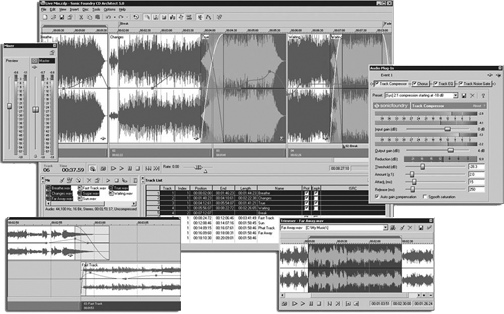
THE INTERFACE
CD Architect’s main window has the consistent look and feel of Sound Forge and Vegas Video. It has two main components: the Time Line on top and the Window Docking area below.
The Time Line area includes the menu bar and customizable Toolbar. The Time Line itself occupies the bulk of the Time Line window’s area and includes not only the waveform display, but also a Time Ruler and a Marker Bar for tagging audio regions with titles and edit points. Below the Time Line window you’ll find the CD Layout bar, with dark gray blocks indicating individual tracks plus their file name, running time, and track number. Index number tabs show up in a gray bar between the waveform display and the blocks. I like the fact that markers and edit points are displayed above the waveforms, and the actual layout of the CD with indices shows up underneath the waveform — it’s a clear layout that very easy on the eyes. Below the CD Layout bar is a time indicator, the transport controls, and the Scrub control.
The Time Ruler is the absolute time reference for each entire CD Project. Right-clicking in it lets you calibrate it in CD time, seconds, minutes, or in SMPTE or feet and frames (yikes!). Beneath that is the Marker Bar, which displays the track or index tabs. You can click and drag these as well, and the track tabs have an additional feature: if you click between track start and end tabs, both are picked up, making it easy to move an entire track without altering its length.
The Transport controls simulate the controls of a CD player, allowing you to play back tracks with all the pauses and settings of your proposed CD. The standard Play, Stop, Next, Previous, Fast Forward, and Rewind buttons are provided, along with Loop and an extra button labeled Emulate CD. When Emulate CD is off, the Next/Previous Event moves between each start and end marker in turn; when it’s on, the Next/Previous Event acts just like a real CD player, jumping between track starts. Track and index indicators are also shown next to the time indicator, and these are exactly what the display of a CD player will show when it plays your CD.
The Window Docking area is one of my favorite interface features of Sonic Foundry’s recent products. In CD Architect, the default Dock holds the meters and several cool windows that are arranged on tabs: an Explorer-type file browser, a Trimmer for performing top and tailing, a Media Pool that lists all the files currently placed in the Time Line, a Track List, and a Playlist. You choose which of these you want to use by clicking on its tab at the bottom.
The Trimmer is quite similar to the one you’ll find in Sonic Foundry’s Acid product. It has its own set of transport controls, along with a button that sends the currently selected region directly to the Time Line. You can create a specific region in the Time Line, and then fill it with part or all of the contents of the Trimmer.
The Playlist is a text-based list of the audio regions in chronological order. It contains the start times, end times, lengths and names of each region currently in your CD Project (as displayed in the Time Line). You can click on any field and edit it using the keyboard, or you can click on the row number (to the left of the actual data), and drag this up or down to a different position, to re-order tracks. It took me a few tries to get the hang of this — you first click on the desired numbered row and release the mouse button, and then click a second time and drag to actually move the track to a new position. This two-click approach allows you the option of clicking and dragging across several rows to select multiple tracks, so that the second click and drag moves several tracks simultaneously.
The Track List is another text-based list, containing track IDs, indices and sub-indices in chronological order. The Track List also includes editable fields for copy protect flags, pre-emphasis flags and ISRC (Industry Standard Recording Codes) data. You do all your editing in the same way: by clicking, dragging and keyboard entry.
The Meters windoid features two Master Faders, which allow overall levels to be set for the entire CD. These affect the final levels written to the CD, and a readout of their current settings appears beneath the faders, calibrated from +12dB to -Inf (Infinity). A separate fader controls the Preview level, which is a new feature and a nice touch.
As slick as these all are, slicker still is the fact that any of these tabbed windows or the meters themselves can be “floated” on the screen by grabbing a bar on the side and dragging the window out of the Docking area. Given enough screen real estate, you can position the important windows (like the meters) up and over the Time Line, leaving more space for the tabbed windows in the Dock. It’s all quite flexible and big fun — now if I could just swing a 42" plasma display I’d be all set.
All things considered, the interface is both clean and complete. If you’re a current Sound Forge or Acid addict, and I certainly am, you’ll get around quite well in CD Architect.

